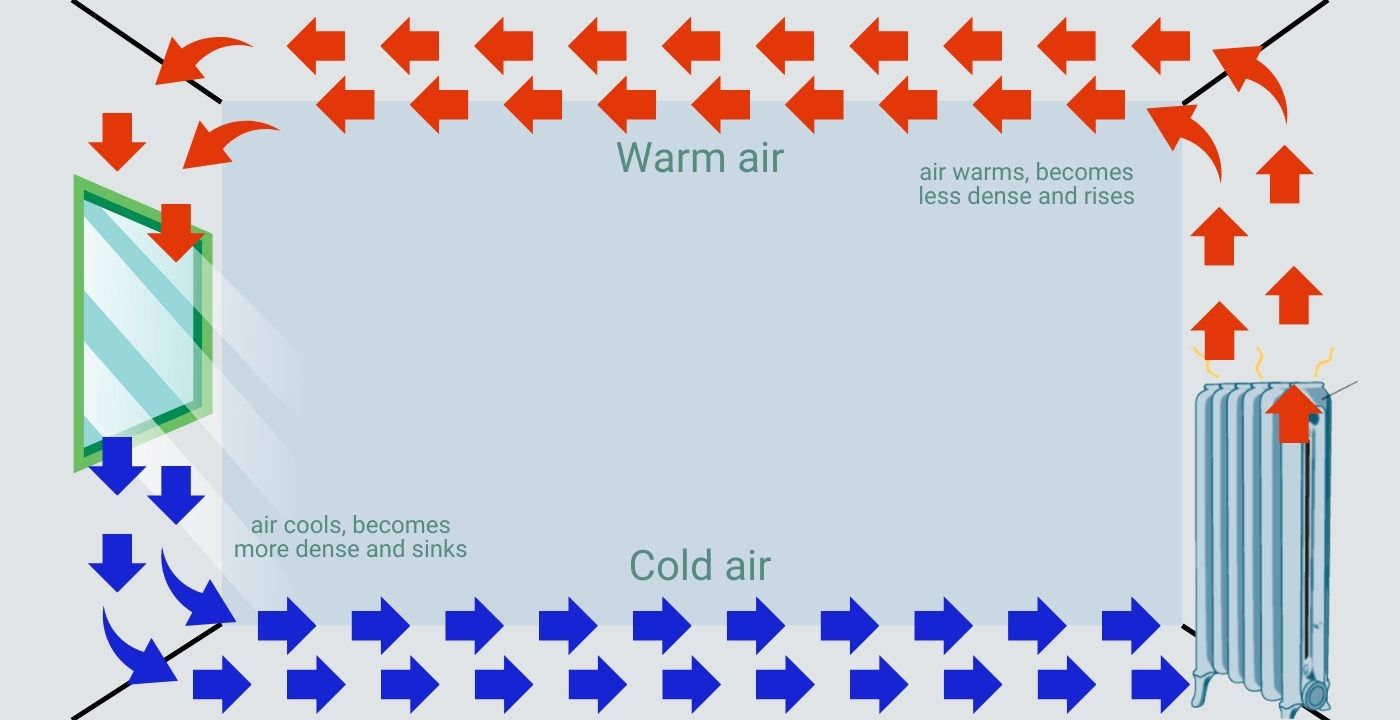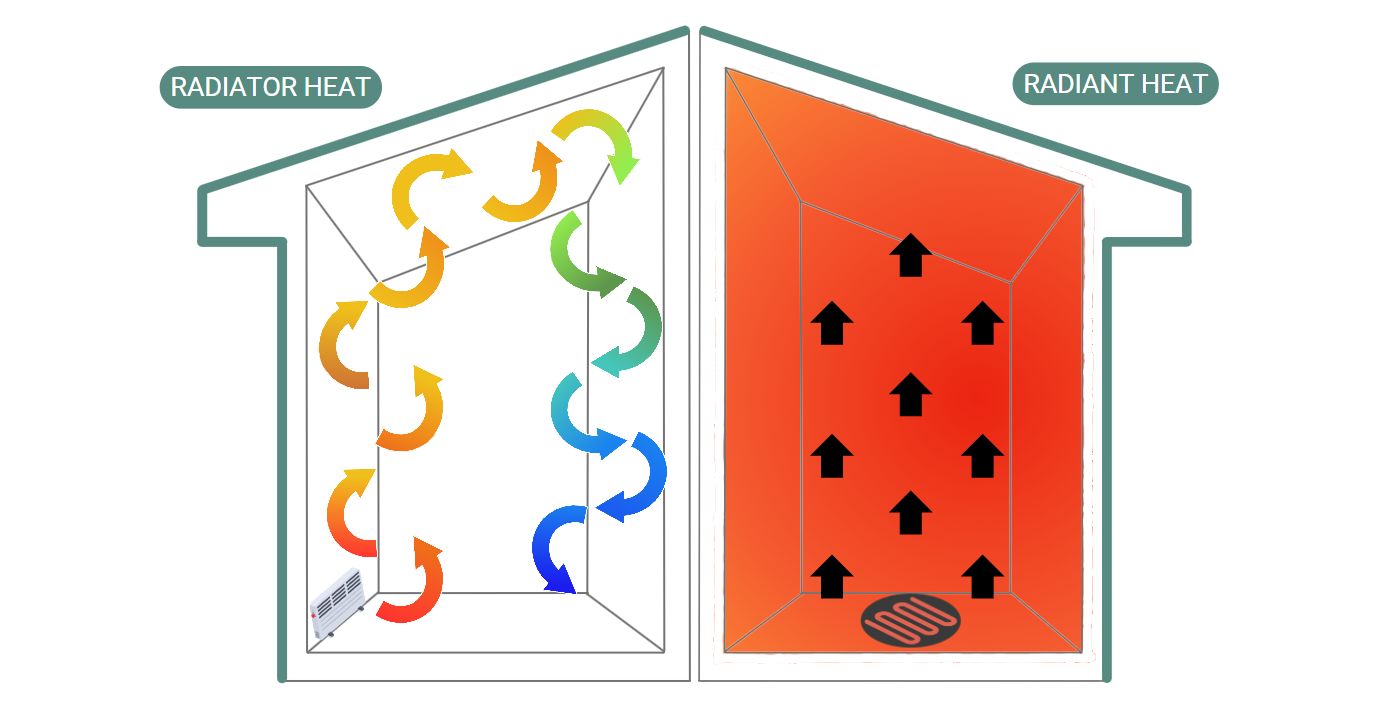Key Takeaways
- Convection and radiant heat are distinct heating methods, each with its operating principle and ideal use-case scenarios.
- Radiant heating directly warms surfaces, objects, and people, providing an immediate and efficient warmth.
- Convection heating heats the air in a space, allowing for a gradual and consistent spread of warmth throughout the room.
What is Convection Heat and How Does it Work?

Convection heating is based on the principle of warm air rising and cold air sinking. When air near a convection heater is warmed, it becomes less dense, causing it to rise.
As this happens, cooler air is drawn towards the heater, gets warmed, and continues the cycle. This cyclic movement of air is what gradually raises the temperature of the entire space.
The process begins with an internal heating element (often a coil or ceramic plate) getting hot. As it does, the surrounding air absorbs this heat.
Over time, this creates a warm air current that moves upward and disperses the warmth throughout the room.
This method is prevalent in central heating systems and many portable heaters.
What is Radiant Heat and How Does it Work?

Radiant heating operates much like the sun. Instead of heating the air, it emits infrared rays that warm objects, surfaces, and people directly in its path.
When these rays strike a surface, they get absorbed, raising its temperature. That object then radiates secondary heat back into the space, contributing to the overall warmth.
A radiant heater contains a coil or filament, which when heated, emits infrared radiation. This radiation travels in straight lines and does not rely on air molecules to transfer heat.
As a result, even in a draughty space, radiant heaters can provide warmth efficiently.
Pros and Cons of Convection Heat
Pros
- Uniform Heating: Convection heaters can achieve consistent temperatures across larger areas.
- Versatility: Many models are designed for dual functionality, acting as cool air fans in warmer months.
- Smart Connectivity: The latest models integrate with smart home systems for automated and efficient temperature control.
- Safety: Many convection heaters come with safety features like tip-over switches and overheat protection.
- Ideal for Extended Use: They maintain room temperature for extended periods, making them suitable for long-duration use.
Cons
- Initial Delay: They take time to achieve the desired room temperature.
- Higher Energy Consumption: Over short periods, they can consume more energy than radiant heaters.
- Potential Dust and Allergen Movement: The circulation of air can redistribute dust particles and allergens.
- Dries Air: They can reduce room humidity, potentially causing discomfort in drier climates.
Pros and Cons of Radiant Heat
Pros
- Immediate Comfort: Provides rapid warmth.
- Precision Heating: Effectively heats targeted areas.
- Energy Efficiency: Short-term operations can be more energy-friendly than convection systems.
- Silent Operations: No fans mean noiseless heating.
- Maintenance-Free: Radiant systems, especially floor heaters, require minimal to no maintenance or servicing.
Cons
- Heat Distribution: Might be uneven in larger homes without supplemental systems.
- Safety: Surfaces close to radiant panels can become hot.
- Installation Costs: Upfront costs for underfloor systems can be higher than convection heaters.
Radiant Heating conveys numerous health benefits over convection heating for people with asthma and other bronchial conditions.
Which is Better Radiant or Convection Heaters?
The infrared vs convection heater debate is nuanced. Radiant systems are champions of quick and targeted warmth—ideal for those who value immediate comfort.
The added advantage of minimal maintenance and the possibility to augment with radiant panels makes them versatile.
Add to this the fact they are better from both a health perspective and better for the environment and radiant heating has a lot going for it. Which isn’t even considering additional advantages radiant heating offers over convection heat systems such as zoned heating capabilities and compatibility with alternative energy sources such as heat pumps and solar.
On the other hand, convection systems, with their even heat distribution, do still offer some benefits for those who prefer a consistently warm home ambiance.
Which One is More Efficient?
Statistically, radiant systems can offer energy efficiencies up to 30% more than their convection counterparts for short-term use.
However, when aiming for a consistently warm home, convection systems with thermostats can save up to 20% energy over extended periods of time.
If you are looking at replacing a furnace system with a radiant heating system take a look at our guide – Can Radiant Floor Heat Mats Replace a Furnace?
Comparison of Radiant Heat vs. Forced Air Systems
| Criteria | Radiant Heat | Forced Air |
|---|---|---|
| Energy Efficiency | High (often 10-30% more efficient than forced air systems) | Moderate to High (Efficiency varies based on system age, design, and ductwork conditions) |
| Installation Costs | $6 to $15 per sq. ft. (Varies based on type and complexity) | $3 to $11 per sq. ft. (Depends on ductwork and system type) |
| Running Costs (Annual) | Typically lower due to higher efficiency, but can vary based on energy rates and system type | Often higher than radiant systems, especially in older homes with potential duct losses |
| Maintenance Costs (Annual) | Very low; often just involves system checks. No regular maintenance needed. | Moderate; regular duct cleaning, filter changes, and potential repairs to moving parts |
| Lifespan | Up to 35 years or more (with proper care) | 15 to 25 years (with regular maintenance) |
| Resale Value Impact | Often seen as a luxury addition, can significantly increase resale value | Can enhance resale value, especially with modern, high-efficiency systems |
| Environmental Impact | Lower carbon footprint, especially when paired with sustainable energy sources | Potentially higher environmental impact, depending on energy source and system efficiency |
| Comfort | Consistent and even heating, no drafts. Warms objects and people directly | Heats the air which can lead to uneven heating and potential drafts |
| System Flexibility | Can be installed under various floor types. Can be zoned for different rooms. | Requires extensive ductwork. Can be zoned, but might require additional infrastructure |
FAQs
How much energy do radiant and convection heating systems use?
Whole-home radiant systems’ energy consumption is determined by factors such as the home size, the type of system (hydronic or electric), and installation coverage.
Typically, these systems can require between 10 to 20 kWh per day for a moderately-sized home, depending on the mentioned factors.
The efficiency of radiant heating means less heat is lost, which often results in energy savings over time.
Convection systems, especially forced air systems, can be more energy-intensive. Heat loss through ducts and the energy required to force air can lead to consumption rates that are 10-30% higher than radiant systems under similar conditions.
Do whole-home radiant and convection systems have different installation costs?
Radiant floor heating systems are often more expensive upfront, ranging from $6 to $15 per square foot electric radiant floor heating, depending on the type and intricacies of the installation. Hydronic can reach up to $20 per square foot. Radiant heat panels, if added for augmented heat, can add to the initial cost.
Convection systems, on the other hand, may range from $3 to $11 per square foot, depending on the complexity of the ductwork and other installation factors.
However, it’s essential to factor in the long-term savings, as radiant systems can often be more cost-effective over their lifespan due to lower maintenance and energy consumption.
What's the lifespan of whole-home radiant and convection heating systems?
Whole-home radiant systems, especially the hydronic variety, boast impressive longevity. With proper care, these systems can last up to 35 years or more.
The absence of moving parts contributes significantly to their durable nature. Radiant heat panels also have a similar lifespan, depending on their quality and usage patterns.
Convection heating systems, in contrast, have a general lifespan of 15 to 20 years. The moving parts and the need for regular maintenance can affect their longevity
Conclusion
While the debate on which is better – radiant or convection heat, still boils down to individual preferences, radiant heating systems are certainly pulling ahead in the race for the best type of home heating system.
Radiant heat is more energy efficient, better for the environment, better for health, more comfortable, and easier to live with due to silent operation and the lack of a need for regular servicing and maintenance than convection heating systems.
However, for those looking for a new home heating solution operating on a limited budget, convection heaters still excel in providing sustained, even heat across larger spaces at a reasonable price point.
By considering factors such as room size, duration of use, installation costs, and energy consumption, one can make an informed decision tailored to their specific requirements.
If you have further questions or would like a radiant heating system specifically tailored to your individual requirements please contact us.





